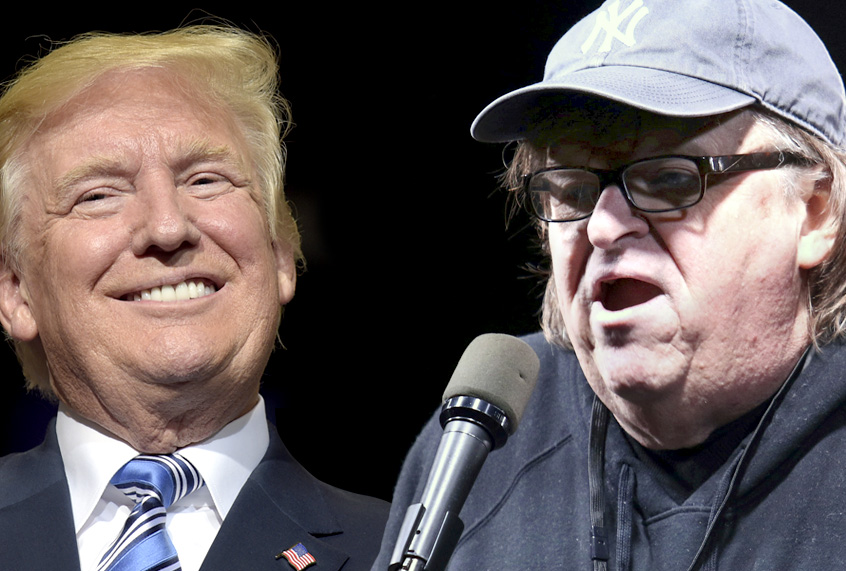Michael Moore’s “Fahrenheit 11/9” (Briarcliff Entertainment) opens Friday in over 1,700 theaters. The release comes in a year that has seen three documentaries gross over $10 million: “Won’t You Be My Neighbor,” “RBG,” and “Three Identical Strangers.” But those successes pale against Moore’s: Three of his films grossed over $30 million at 2018 ticket prices, with “Fahrenheit 9/11” at a staggering $178 million.
As always, Moore is his film’s marketing campaign; he’s gambling that he can recreate the appeal of “Bowling For Columbine” and “9/11″after a decade of seeing his films face declining results. His biggest hits came in the early George W. Bush years, when he was positioned as part of the resistance. (His last two documentaries came while Obama was president.) His last film, “Where To Invade Next,” grossed just $3.8 million in February 2016 — but that was months before anyone took Donald Trump seriously.
This cycle works both ways. Moore’s right-wing doppelganger Dinesh D’Sousa made three anti-Obama and Clinton documentaries between 2012-2016: “Obama’s America,” “Hillary’s America,” and “America.” All grossed as well or better than Moore’s documentaries during the same period. But his most recent release, “Death of a Nation,” didn’t top $6 million despite a 1,000-theater opening.
Read more IndieWire: ‘Fahrenheit 11/9’ Review: Michael Moore Compares Trump to Hitler in a Sprawling Quest to Save America — TIFF
Will the current climate help “11/9”? The industry is unsure. Pre-opening estimates range from $5 million-$8 million. With 2018 being a strong year for documentaries, it’s possible that Moore could follow suit — perhaps reaching the level of “Won’t You Be My Neighbor” at $22.6 million.
But the three big hits of 2018 are far removed from the polemical “11/9.” Films about Fred Rogers and Supreme Court Justice Ruth Bader Ginsberg each center on positive, comforting figures more than their political messages. “Three Identical Strangers” caught fire with its sensational story. “11/9,” like all of Moore’s films, isn’t designed to comfort, with pointed comments about Democratic and Republican leaders alike.
Ultimately, Moore will be measured against himself. When he made his filmmaking debut in 1989, documentaries rarely grossed more than $1 million (adjusted, as all figures here). Miramax had a breakout with Errol Morris’ “The Thin Blue Line” in 1988 ($2.7 million), which suggested some commercial potential for specialized nonfiction films.
Read more IndieWire: Michael Moore Turns ‘Fahrenheit 11/9’ Premiere Q&A Over to Parkland Survivors and Flint Whistleblowers — TIFF
“Roger and Me” debuted with a splash at Telluride and the Toronto International Film Festival. It came without a distributor, but it did have John Pierson as its sales agent (he also repped “The Thin Blue Line”). It became the center of interest by the usual specialized players, but ultimately went to Warner Bros. — a studio that rarely got involved with specialized films, let alone non-concert documentaries. It released the film limited in December, then expanded in January to 265 theaters to earn $14.7 million adjusted.
Documentaries became a key element in the specialized theatrical world. In the next three years, the market responded with five documentaries that grossed $2 million or more, with “Paris Is Burning” tops at $8.3 million. In 1994, “Hoop Dreams” (another Pierson-repped title) made $16.7 million.
While Moore’s 1997 look at money and politics, “The Big One,” stalled out at $1.4 million, he changed the conversation again in 2002 with “Bowling for Columbine” ($34 million) and with “Fahrenheit 9/11” in 2004. Its box officeexceeded Oscar Best Picture contenders “Million Dollar Baby,” “The Aviator,” and “Sideways” as well as popular hits like “Mean Girls,” “Collatoral,” “The Terminal,” and “Ray.”
Read more IndieWire: ‘Museo’ Leads Crowded Field of Specialty Box Office Openers as ‘The Wife’ Continues to Soar
That hasn’t happened since. Moore followed with “Sicko” in 2007, about U.S. medical care ($24.5 million), and “Capitalism: A Love Story” in 2009 ($14.4 million).
That suggests no guarantee his audience will support the wide release of “Fahrenheit 11/9.” It’s the first film for Briarcliffe, a distribution company launched by Tom Ortenberg; he and Moore previously collaborated on “Fahrenheit 9/11,” when Ortenberg worked at Lions Gate Films. Word of mouth and continued publicity will be needed to keep it around.
Expecting even Moore’s “Columbine” results is almost certainly too high a standard. Though we don’t know the marketing or other expenses, success for “11/9” likely can be achieved at a lower gross. Moore needs a success after “Where to Invade Next,” but when it comes to the high box-office standards for documentaries — well, he has no one to blame but himself.

